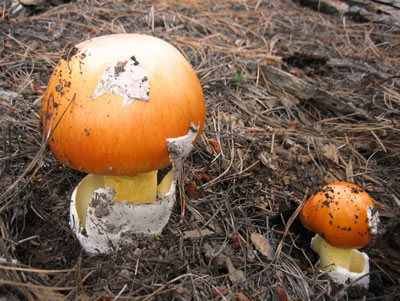Stems and stem bases
Scabrous stems
The genus Leccinum, which belongs in the Boletes, is identified by scabers on the stem. These are little darkened outcroppings of tissue, similar to scales, that often are present throughout the stem.
When you find a mushroom with these scabers, you will first check to make sure it has pores instead of gills (making it a Bolete). Then you know it is a member of Leccinum, which is full of great edibles like the Aspen Bolete in this picture.
I can't think of any other mushroom, pored or gilled, that has this feature. It is what makes Aspen Boletes so easy to identify!
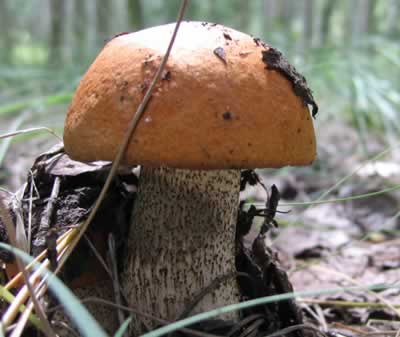
Scaly stems
Some groups of mushrooms are well known for their scaliness. Many mushrooms have scaly caps, but the list narrows down considerably when the stems are also scaly. Compared to the scabers described above, scales are much larger and are typically the same color as the stem.
The photo to the right is from the almost exclusively scaly genus Pholiota. If you find an orange-brown scaly cluster of mushrooms coming out of wood (sometimes buried or decomposed), it's a good bet you are looking at a Pholiota.
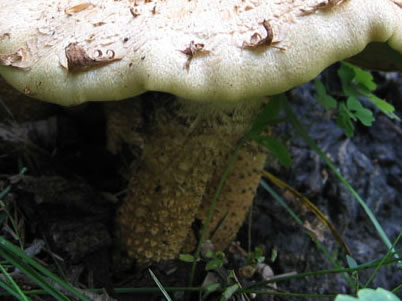
Reticulated stems
I only know of one group of mushrooms that posess reticulated stems: the genus Boletus and some close relatives. Reticulation looks like capillaries are etched across the skin of the stem, and are usually most prominent near the cap.
The photo to the right is of Boletus pulcherrimus, a poisonous bolete. The genus Boletus also contains some of the best edibles in the fungal kingdom, including the King Bolete, Boletus edulis! If you find a bolete that has a reticulated stem, it's very likely it is a Boletus and deserves your close attention!
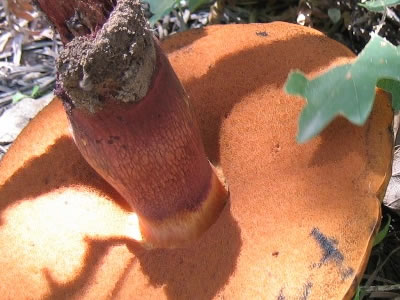
Wiry stems
Some groups of mushrooms are known for their especially thin, wiry stems. This typically isn't enough to identify the mushroom to genus, but a wiry stem can rule out many possibilities. I wanted to demonstrate this character as an example of stem width and cap to stem ratios that can be diagnostic.
The mushrooms to the right belong to the genus Marasmius. Many members of Marasmius are important leaf and needle decomposers in forest humus. The best known edible from this genus is Marasmius oreades, the fairy ring mushroom, but it does posess a thicker stem than those in the photo.
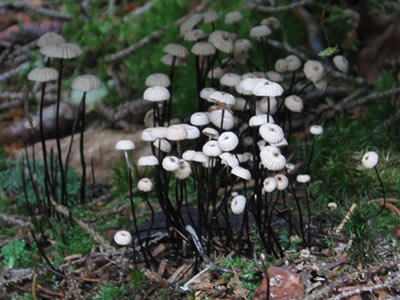
Velvet-footed stems
A velvet-footed stem is an example of how appearance and texture of the stem can change along its length. It isn't terribly obvious in this photo, but if you held this mushroom in the sun light you would notice how the lower half is velvety and absorbs light.
The mushroom to the right is Flammulina velutipes, which translates to "velvet footed". This character is diagnostic for the mushroom, along with several other properties such as white spore color, and makes it fairly easy to identify. F. velutipes is a great edible and can be common in certain regions, although it is fairly small so requires many to be worth gathering. This mushroom is grown commercially in oxygen and light deprived rooms, which cause the stems to elongate and prevents pigments from developing. In this form it is called "Enoki" or "Enokitake" ,and you can sometimes find it in places like "Whole Foods" and other high-end grocery stores or asian markets.
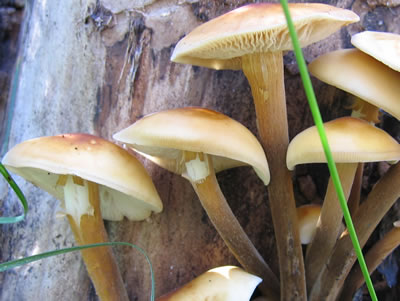
Wooly-footed stems
Some mushrooms are known as "Wooly-footed" as the mycelium at the development site continues to grow a bit as the mushroom matures. This is fairly rare across most taxa and can be a good diagnostic character.
The mushroom to the right is not identified but most likely a member of the leaf litter and wood decomposers Mycena. The wooly-foot character is shared mostly among certain small mushrooms. One mushroom gets its common name directly from this character: the "Wooly-footed collybia".
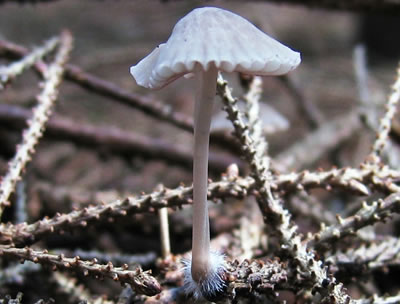
Bulbous bases
A common and very important group of mushrooms is well known for its unique features at the base of the stem. The genus Amanita has a unique mushroom development process, which begins as an "egg". The mushroom bursts out of the top of this "egg" as it matures, leaving the remnants behind (some tissue remained on the cap, forming "warts", as you can see in the photo to the right).
Amanitas can be identified not only by the presence of their bulbous base, but also by their specific characters. Some are notched, some are scaly, and as you will see below, some form a cup-shaped remnant called a...
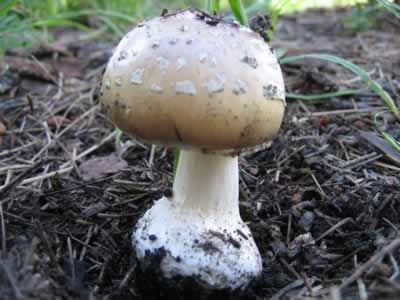
Volva
As mentioned above, all members of the genus Amanita begin their early mushroom development as an "egg". For certain species of Amanita, the egg remnant takes the shape of a cup or sac at the base of the stem, which is called a volva.
To my immediate recollection, only two genera are known to produce these sacs at the base of the stem: Amanita, and Volvariella. Amanitas are well known for their especially deadly species such as the Death Cap and Destroying Angel. Volvariella is well known as the commercially sold "Paddy Straw Mushroom" that you can find in most grocery stores. Many mushroom poisonings occur in the US among asian immigrants who mistake deadly Amanitas for their well known asian lookalike.
